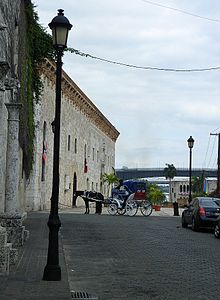Real Audiencia of Santo Domingo
The Real Audiencia of Santo Domingo (in Spanish in full: Audiencia y Cancillería Real de Santo Domingo en la Isla Española ) was a court in Santo Domingo , an institution of colonial administration and at the same time a judicial district ( Real Audiencia ) of the Spanish crown. It existed from 1511 to 1795 as part of the viceroyalty of New Spain .
The role of the Real Audiencias in the colonies
After the conquest of Central and South America ( Conquista ) by the Spaniards, King Charles V issued the “Laws on India” (Spanish: Leyes de Indias ) as well as the “New Laws” (Spanish: Leyes Nuevas ), in which he is the administration of the overseas colonies in the "Viceroyalty of New Castile" organized and regulated.
The Real Audiencias were responsible for the implementation of the laws and the support of the military governors . They fulfilled tasks in administration and finance that went far beyond that of a court according to today's understanding, especially as a separation of powers was unknown. In addition to a chairman and usually four judges (Spanish: Oidores ), there was a public prosecutor (Spanish: fiscal ), but also subordinate executive forces such as a bailiff (Spanish: alguacil mayor ), police officers, translators, etc.
The foundation in 1511
After the landing of Christopher Columbus in Hispaniola in 1492, the Spanish established colonial rule on the island. In 1511 King Ferdinand V made the governor Diego Columbus (viceroy) viceroy and placed a Real Audiencia in Santo Domingo at his side. Diego Columbus, of course, opposed the crown and fought for more personal power than the king would allow him. He also took over the jurisdiction on his own.
The occupation was delayed until Diego Columbus returned to Spain and King Charles V ordered an audiencia to be set up in 1526. It was the first Audiencia in the New World, followed the following year by the Real Audiencia of Mexico , which is responsible for the mainland (1528). The Audiencias of Panamá (1538) and Lima and Guatemala (1543) followed later.
Jurisdiction
The Audiencia of Santo Domingo was initially responsible for the entire newly conquered territory. With the establishment of further audiences, the responsibility was increasingly shared. From 1547 the Audiencia was responsible for the island area of the Caribbean, later also for the Spanish possessions in Florida and Louisiana (colony) as well as the north of today's Venezuela .
Audiencia in the Viceroyalty
With the establishment of the viceroyalty of New Spain , the chairman also reported to the viceroy in Mexico City as captain general of Santo Domingo.
With the growth of the colony, Hispaniola lost its importance in the Spanish colonial empire. The mineral resources, which were the main driving force behind colonial rule in Spain, came from the mainland; the most important ports for transatlantic trade were established in Veracruz (Veracruz) and Havana in Cuba .
Concretization of the tasks 1680
With the Recopilación de Leyes de Indias in 1680, the Spanish Crown summarized the individual provisions in the New World that had been enacted over the years into one legal text. A number of four oidores was set for the Audiencia of Santo Domingo .
Reforms
With the establishment of the Viceroyalty of New Granada , responsibility for the provinces on the Venezuelan mainland was initially transferred to the Real Audiencia of Santa Fé de Bogotá in 1718 and finally in 1740 .
Relocation and dissolution
In the Treaty of Basel in 1795, Spain ceded the island of Hispaniola to France . The administration over the Spanish Caribbean as well as Louisiana and Florida moved to Puerto Príncipe (today's Camagüey in Cuba). In the years that followed, the Spanish struggled against Napoleon Bonaparte , and the colonies in America gradually became independent or ceded. The jurisdiction and colonial administration extended only to the islands of Cuba and Puerto Rico.
A separate audiencia was set up for Puerto Rico in 1835. In 1838 the Spaniards founded another Audiencia in Havana , which was responsible for western Cuba, while the existing Audiencia was henceforth limited to eastern Cuba. With Cuban independence, administration and jurisdiction were transferred to the Republic of Cuba.
Sources and web links
- Background article on the Real Audiencias (Spanish)
- ( Page no longer available , search in web archives: The Leyes de Indias from 1680 ) (Spanish): PDF; 3.7 MB
- Manuel Aranda Mendíaz: Visiones Sobre el Primer Tribunal de Justicia de la América Hispana: La Real Audiencia de Santo Domingo . Campillo Nevado, Madrid 2007, ISBN 978-84-612-1710-6 ( repositorio.ulpgc.es [PDF; accessed June 23, 2015]).

